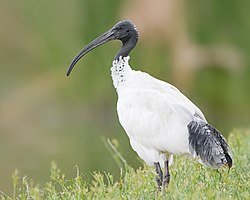| Common name | Binomial name | Population | Status | Trend | Notes | Image |
|---|
| White-bellied heron | Ardea insignis | 50-249 [9] | CR [9] |  [9] [9] | Total population is estimated to be 70-400 individuals. | 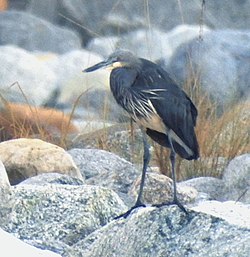 |
| Dwarf ibis (São Tomé ibis) | Bostrychia bocagei | 130-1,700 [10] | CR [10] |  [10] [10] | Estimate calculated from density and area estimates. Total population estimated to be 190-2,500 individuals. [10] |  |
| Giant ibis | Thaumatibis gigantea | 194 [11] | CR [11] |  [11] [11] | Minimum estimate. Total population estimated to be 290 individuals. [11] |  |
| Northern bald ibis | Geronticus eremita | 200-249 [12] | EN [12] |  [12] [12] | Estimate for mature individuals only. Species is considered regionally extinct in Europe. [12] |  |
| Asian crested ibis (Crested ibis) | Nipponia nippon | 330 [13] | EN [13] |  [13] [13] | Total population estimated to be 550 individuals. [13] |  |
| White-shouldered ibis | Pseudibis davisoni | 670 [14] | CR [14] |  [14] [14] | Minimum estimate. Estimate for total population is 1,000 individuals. [14] |  |
| Malagasy pond heron | Ardeola idae | 1,000-2,499 [15] | EN [15] |  [15] [15] | Estimate is for mature individuals only. [15] |  |
| Australasian bittern | Botaurus poiciloptilus | 1,000-2,499 [16] | VU [16] |  [16] [16] | |  |
| Madagascar heron (Humblot's heron) | Ardea humbloti | 1,290-1,500 [17] | EN [17] |  [17] [17] | Estimate is for mature individuals only. [17] | 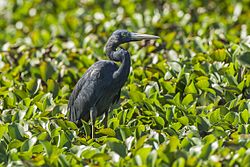 |
| Malayan night heron | Gorsachius melanolophus | 1,300-13,000 [18] | LC [19] | ? [19] | Population on most recent IUCN assessment (2025) Is unknown. [19] Values retained from 2016 assessment. [18] |  |
| Forest bittern | Zonerodius heliosylus | 1,500-7,000 [20] | NT [20] |  [20] [20] | Total population is estimated to be 2,500-9,999 individuals. [20] |  |
| White-eared night heron | Oroanassa magnifica | 1,500-15,000 [21] | NT [21] |  [21] [21] | | 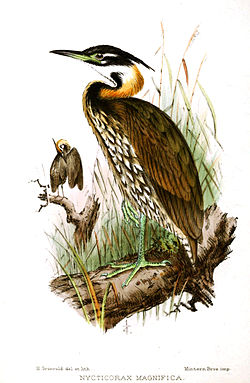 |
| Malagasy sacred ibis | Threskiornis bernieri | 1,733-2,166 [22] | EN [22] |  [22] [22] | Total population is estimated to be 2,600-3,250 individuals. [22] |  |
| Slaty egret | Egretta vinaceigula | 2,500-3,000 [23] | VU [23] |  [23] [23] | Total population is estimated to be 3,000-5,000 individuals. [23] |  |
| Madagascar crested ibis (Madagascar ibis) | Lophotibis cristata | 2,500-9,999 [24] | VU [24] |  [24] [24] | Total population is estimated to be <10,000 individuals. [24] |  |
| Andean ibis | Theristicus branickii | 2,500-9,999 [25] | NT [25] |  [25] [25] | Total population is estimate to be 4,250-13,400 individuals. [25] |  |
| Schrenck's bittern (Von Schrenk's bittern) | Botaurus eurhythmus | 2,500-25,000 [26] | NT [26] |  [26] [26] | Total population estimated to be 1,000-50,000 individuals. [26] IUCN/BirdLife International still place this bird in genus Ixobrychus. |  |
| Black-faced spoonbill | Platalea minor | 3,000-5,100 [27] | VU [27] |  [27] [27] | Total population estimated to be 6,500-7,500 individuals. [27] | 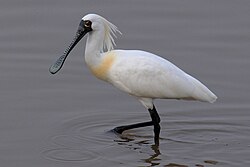 |
| Shoebill | Balaeniceps rex | 3,300-5,300 [28] | VU [28] |  [28] [28] | Total population estimated to be 5,000-8,000 individuals. [28] |  |
| Chinese egret | Egretta eulophotes | 4,000-6,000 [29] | VU [29] |  [29] [29] | Estimate is for mature individuals only. [29] |  |
| Japanese night heron | Gorsachius goisagi | 5,000-9,999 [30] | VU [30] |  [30] [30] | Total population is estimated to be 7,500-15,000 individuals. [30] |  |
| Reddish egret | Egretta rufescens | 5,000-9,999 [31] | NT [31] |  [31] [31] | Estimate for mature individuals only. [31] |  |
| Puna ibis | Plegadis ridgwayi | 5,000-20,000 [32] | LC [32] |  [32] [32] | Population estimate is highly uncertain. [32] |  |
| Yellow-billed spoonbill | Platalea flavipes | 6,600-16,600 [33] | LC [33] |  [33] [33] | Total population is estimated to be 10,000-25,000 individuals. [33] |  |
| White-necked heron | Ardea pacifica | 6,700-16,700 [34] | LC [34] |  [34] [34] | Total population is estimated to be 10,000-25,000 individuals. [34] |  |
| White-faced heron | Egretta novaehollandiae | 6,700-66,700 [35] | LC [35] | ? [35] | Total population is estimated to be 9,999-99,999 individuals. [35] |  |
| Rufous-bellied heron | Ardeola rufiventris | 6,700-66,700 [36] | LC [36] |  [36] [36] | Total population is estimated to be 10,000-100,000 individuals. [36] |  |
| Goliath heron | Ardea goliath | 6,700-66,700 [37] | LC [37] |  [37] [37] | Total population is estimated to be 10,070-100,070 individuals. [37] |  |
| Southern bald ibis | Geronticus calvus | 7,000-8,000 [38] | NT [38] |  [38] [38] | Estimate is for mature individuals only. [38] |  |
| Spot-billed pelican | Pelecanus philippensis | 8,700-12,000 [39] | NT [39] |  [39] [39] | Total population is estimated to be 13,000-18,000 individuals. [39] |  |
| Australian little bittern (Black-backed bittern) | Botaurus dubius | <10,000 [40] | LC [40] |  [40] [40] | Value given is a tentative guess for number of mature individuals. [40] IUCN/BirdLife International still places species in Ixobrychus. |  |
| Agami heron | Agamia agami | 10,000-25,000 [41] | NT [41] |  [41] [41] | Values given are a shaky estimate of number of mature individuals. [41] | 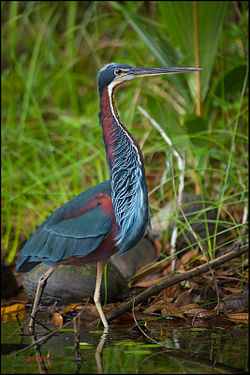 |
| Wattled ibis | Bostrychia carunculata | 10,000-25,000 [42] | LC [42] | ? [42] | |  |
| Sharp-tailed ibis | Cercibis oxycerca | 10,000-25,000 [43] | LC [43] | ? [43] | Values given are for total population. This estimate is now considered outdated. [43] |  |
| Dalmatian pelican | Pelecanus crispus | 11,400-13,400 [44] | NT [44] |  [44] [44] | Estimate is for mature individuals only. [44] |  |
| Great-billed heron | Ardea sumatrana | 11,700-71,700 [45] | LC [45] |  [45] [45] | Total population is estimated to be 17,500-107,500 individuals. [45] |  |
| Olive ibis | Bostrychia olivacea | 15,000-45,000 [46] | LC [46] |  [46] [46] | Total population is estimated to be <45,000 individuals. [46] |  |
| Pied heron | Egretta picata | 16,700-66,700 [47] | LC [47] | ? [47] | Total population is estimated to be 25,000-100,000 individuals. [47] |  |
| Black-faced ibis | Theristicus melanopis | 16,700-66,700 [48] | LC [48] |  [48] [48] | Total population is estimated to be 25,000-100,000 individuals. [48] |  |
| Dwarf bittern | Botaurus sturmii | 16,700-66,700 [49] | LC [49] | ? [49] | Total population is estimated to be 25,000-100,000 individuals. [49] IUCN/BirdLife International still place this bird in genus Ixobrychus. |  |
| Black heron | Egretta ardesiaca | 16,700-66,700 [50] | LC [50] |  [50] [50] | Total population is estimated to be 25,000-100,000 individuals. [50] |  |
| Yellow-billed egret | Ardea brachyrhyncha | 16,700-66,700 [51] | LC [51] |  [51] [51] | Total population is estimated to be 25,000-100,000 individuals. [51] |  |
| Chinese pond heron | Ardeola bacchus | 16,700-667,000 [52] | LC [52] |  [52] [52] | Total population is estimated to be 25,000-1,000,000 individuals. [52] |  |
| Rufescent tiger-heron | Tigrisoma lineatum | 18,000-70,000 [53] | LC [53] |  [53] [53] | Total population is estimated to be 27,700-105,500 individuals. [53] Note: the banner population and population description sections of the cited IUCN assessment disagree. Provided values were chosen to be reported based on agreement between mature and total individual estimates. |  |
| Fasciated tiger-heron | Tigrisoma fasciatum | 20,000-49,999 [54] | LC [54] |  [54] [54] | Tentative estimate, which is higher than the Wetlands International estimate for total population (c.14,500-17,000 individuals). [54] |  |
| African spoonbill | Platalea alba | 20,700-46,700 [55] | LC [55] |  [55] [55] | Total population is estimated to be 31,000-70,000 individuals. [55] |  |
| Whistling heron | Syrigma sibilatrix | 23,300-73,300 [56] | LC [56] |  [56] [56] | Total population is estimated to be 35,000-110,000 individuals. [56] |  |
| Nankeen night heron | Nycticorax caledonicus | 24,700-743,000 [57] | LC [57] |  [57] [57] | Total population is estimated to be 37,000-1,113,999 individuals. [57] |  |
| White-backed night heron | Calherodius leuconotus | 25,000-100,000 [58] | LC [58] |  [58] [58] | Values given are for total population. [58] |  |
| White-crested tiger-heron | Tigrionrnis leucolopha | 25,000-100,000 [59] | LC [59] |  [59] [59] | Values given are for total population. [59] |  |
| Royal spoonbill | Platalea regia | 25,000-100,000 [60] | LC [60] |  [60] [60] | Values given are for total population. May be an underestimate. [60] |  |
| Black bittern | Botaurus flavicollis | 30,000-214,000 [61] | LC [61] | ? [61] | Total population is estimated to be 45,002-320,499 individuals. [61] IUCN/BirdLife International still place this bird in genus Ixobrychus. |  |
| Pink-backed pelican | Pelecanus rufescens | 33,300-66,700 [62] | LC [62] |  [62] [62] | Total population is estimated to be 50,000-100,000 individuals. [62] |  |
| Plumbeous ibis | Theristicus caerulescens | 33,300-66,700 [63] | LC [63] |  [63] [63] | Total population is estimated to be 50,000-100,000 individuals. [63] |  |
| Buff-necked ibis | Theristicus caudatus | 33,300-133,000 [64] | LC [64] |  [64] [64] | Total population is estimate to be 50,000-200,000 individuals. [64] |  |
| Western reef-egret (Western reef heron) | Egretta gularis | 36,000-92,700 [65] | LC [65] |  [65] [65] | Total population is estimated to be 54,000-139,000 individuals. [65] Note that IOC taxonomy splits one additional species, the dimorphic egret, from this species. [1] IUCN/BirdLife International maintain both species under E. gularis. [66] |  |
| Australian pelican | Pelecanus conspicillatus | 46,700-200,000 [67] | LC [67] |  [67] [67] | Total population is estimated to be 70,000-300,000 individuals. [67] |  |
| Hadada ibis | Bostrychia hagedash | 46,700-267,000 [68] | LC [68] | ? [68] | Total population is estimated to be 70,000-400,000 individuals. [68] |  |
| Capped heron | Pilherodius pileatus | 50,000-499,999 [69] | LC [69] |  [69] [69] | Values given are for total population. [69] |  |
| Bare-throated tiger-heron | Tigrisoma mexicanum | 50,000-499,999 [70] | LC [70] |  [70] [70] | Estimate is for mature individuals only. [70] | 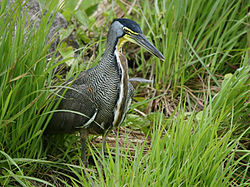 |
| Pinnated bittern | Botaurus pinnatus | 50,000-499,999 [71] | LC [71] |  [71] [71] | Estimate is for mature individuals only. [71] |  |
| Green ibis | Mesembrinibis cayennensis | 50,000-499,999 [72] | LC [72] |  [72] [72] | Estimate is for mature individuals only. [72] |  |
| Eurasian spoonbill | Platelea leucorodia | 52,800-63,900 [73] | LC [73] |  [73] [73] | Total population is estimated to be 79,250-95,850 individuals. [73] |  |
| Scarlet ibis | Eudocimus ruber | 66,700-100,000 [74] | LC [74] |  [74] [74] | Total population is estimated to be 100,000-150,000 individuals. [74] | 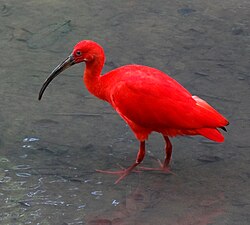 |
| Black-headed heron | Ardea melanocephala | 66,700-333,000 [75] | LC [75] |  [75] [75] | Total population is estimated to be 100,000-500,000 individuals. [75] |  |
| Indian pond heron | Ardeola grayii | 66,700-667,000 [76] | LC [76] | ? [76] | Total population is estimated to be 99,998-999,998 individuals. [76] |  |
| Plumed egret | Ardea plumifera | 66,700-667,000 [77] | LC [77] | ? [77] | Total population is estimated to be 100,000-1,000,000 individuals. [77] |  |
| Yellow bittern | Botaurus sinensis | 66,700-667,000 [78] | LC [78] | ? [78] | Total population is estimated to be 100,000-1,000,299 individuals. [78] IUCN/BirdLife International still place this bird in genus Ixobrychus. |  |
| Roseate spoonbill | Platalea ajaja | 68,500-171,000 [79] | LC [79] |  [79] [79] | Total population is estimated to be 102,800-256,800 individuals. [79] |  |
| Stripe-backed bittern | Botaurus involucris | 73,300-683,000 [80] | LC [80] |  [80] [80] | Total population is estimated to be 110,000-1,025,000 individuals. [80] IUCN/BirdLife International still place this bird in genus Ixobrychus. |  |
| Bare-faced ibis | Phimosus infuscatus | 83,300-733,000 [81] | LC [81] |  [81] [81] | Total population is estimated to be 124,999-1,099,999 individuals. [81] | 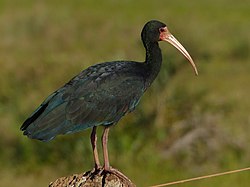 |
| Cinnamon bittern | Botaurus cinnamomeus | 83,300-1,330,000 [82] | LC [82] | ? [82] | Total population is estimated to be 125,000-2,000,000 individuals. [82] IUCN/BirdLife International still place this bird in genus Ixobrychus. |  |
| Least bittern | Botaurus exilis | 93,300-106,000 [83] | LC [83] |  [83] [83] | Total population is estimated to be 139,999-158,999 individuals. [83] IUCN/BirdLife International still place this bird in genus Ixobrychus. |  |
| American white pelican | Pelecanus erythrorhynchos | 100,000-499,999 [84] | LC [84] |  [84] [84] | Best estimate for number of mature individuals is 450,000. [84] |  |
| Straw-necked ibis | Threskiornis spinicollis | 100,000-1,000,000 [85] | LC [85] |  [85] [85] | Values given are for total population. [85] |  |
| Peruvian pelican | Pelecanus thagus | 100,000-1,000,000 [86] | NT [86] |  [86] [86] | Values given are for total population. [86] |  |
| Pacific reef-egret (Pacific reef heron) | Egretta sacra | 100,000-1,000,000 [87] | LC [87] |  [87] [87] | Values given are for total population. [87] |  |
| Hamerkop | Scopus umbretta | 113,000-743,000 [88] | LC [88] | ? [88] | Total population is estimated to be 170,000-1,115,000 individuals. [88] |  |
| Glossy ibis | Plegadis falcinellus | 119,000-860,000 [89] | LC [89] |  [89] [89] | Total population is estimated to be 178,500-1,289,499 individuals. [89] | 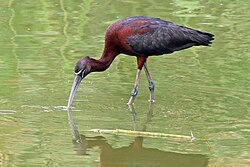 |
| Green-backed heron (Striated heron) | Butorides striata | 173,000-1,500,000 [90] | LC [90] |  [90] [90] | Total population is estimated to be 260,000-2,300,000 individuals. [90] Note that IOC taxonomy splits three additional species, green heron, little heron, and lava heron, from this species. [1] IUCN/BirdLife International maintain all four species under B. striata. [66] | 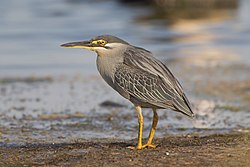 |
| Purple heron | Ardea purpurea | 180,000-380,000 [91] | LC [91] |  [91] [91] | Total population is estimated to be 270,000-570,000 individuals. [91] |  |
| Eurasian bittern | Botaurus stellaris | 184,000-310,000 [92] | LC [92] |  [92] [92] | Total population is estimated to be 275,699-465,199 individuals. [92] |  |
| African sacred ibis | Threskiornis aethiopicus | 200,000-450,000 [93] | LC [93] |  [93] [93] | Estimate is for mature individuals only. [93] |  |
| Spot-breasted ibis | Bostrychia rara | 200,000-510,000 [94] | LC [94] |  [94] [94] | Values given are for total population. [94] |  |
| Tricolored heron | Egretta tricolor | 206,000-219,000 [95] | LC [95] |  [95] [95] | Total population is estimated to be 308,350-328,699 individuals. [95] |  |
| White ibis (American white ibis) | Eudocimus albus | 210,000-360,000 [96] | LC [96] |  [96] [96] | Estimate is for mature individuals only. [96] |  |
| Black-headed ibis | Threskiornis melanocephalus | 250,000-500,000 [97] | LC [97] |  [97] [97] | Total population is estimated to be 400,000-600,000. [97] |  |
| Great white pelican | Pelecanus onocrotalus | 265,000-295,000 [98] | LC [98] | ? [98] | Values given are for total population. [98] |  |
| Little blue heron | Egretta caerulea | 275,000-392,000 [99] | LC [99] |  [99] [99] | Total population is estimated to be 413,001-587,400 individuals. [99] |  |
| Brown pelican | Pelecanus occidentalis | 300,000 [100] | LC [100] |  [100] [100] | Values given are for total population. [100] |  |
| Squacco heron | Ardeola rallodies | 370,000-780,000 [101] | LC [101] |  [101] [101] | Values given are for total population. European subpopulation estimated at 30,000-51,700 mature individuals. [101] | 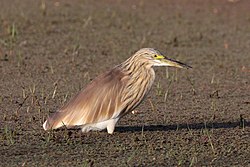 |
| Little egret | Egretta garzetta | 430,000-2,100,000 [102] | LC [102] |  [102] [102] | Estimate is for mature individuals only. [102] |  |
| Black-crowned night heron | Nycticorax nycticorax | 440,000-1,990,000 [103] | LC [103] | ? [103] | Total population is estimated to be 663,000-2,985,000 individuals. [103] |  |
| Snowy egret | Egretta thula | 476,000-1,620,000 [104] | LC [104] |  [104] [104] | Total population is estimated to be 713,800-2,428,000 individuals. [104] |  |
| Grey heron | Ardea cinerea | 500,000-2,500,000 [105] | LC [105] | ? [105] | Total population is estimated to be 790,000-3,700,000 individuals. [105] |  |
| Great blue heron | Ardea herodias | 500,000-4,999,999 [106] | LC [106] |  [106] [106] | Estimate is for mature individuals only. [106] |  |
| Boat-billed heron | Cochlearius cochlearius | 500,000-4,999,999 [107] | LC [107] |  [107] [107] | Values given are for total population. [107] |  |
| Common little bittern (Little bittern) | Botaurus minutus | 600,000-1,199,999 [108] | LC [108] |  [108] [108] | IUCN/BirdLife International still place this bird in genus Ixobrychus. Very preliminary estimate is for mature individuals only. [108] | 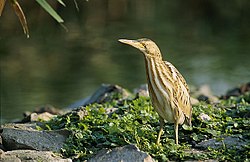 |
| White-faced ibis | Plegadis chihi | 1,000,000-9,999,999 [109] | LC [109] |  [109] [109] | Best estimate for number of mature individuals is 7.2 million. [109] |  |
| Great white egret (Great egret) | Ardea alba | 1,100,000-1,600,000 [110] | LC [110] |  [110] [110] | Total population is estimated to be 1.6-2.4 million individuals. [110] |  |
| American bittern | Botaurus lentiginosus | 1,500,000-2,500,000 [111] | LC [111] |  [111] [111] | Total population is estimated to be 3.0 million individuals. [111] |  |
| Cattle egret | Bubulcus ibis | 2,600,000-12,600,000 [112] | LC [112] |  [112] [112] | Note than IOC taxonomy splits this species into two species, Eastern and Western cattle egret, both placed in the Ardea genus. [1] IUCN/BirdLife International maintain both species under Bubulcus ibis. [66] |  |
| Cocoi heron | Ardea cocoi | 5,000,000-49,999,999 [113] | LC [113] |  [113] [113] | Estimate is for mature individuals only. [113] |  |
|













































































































